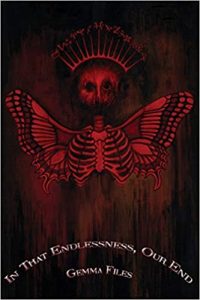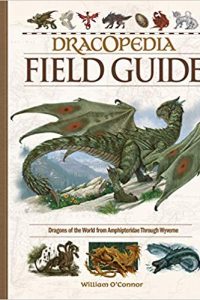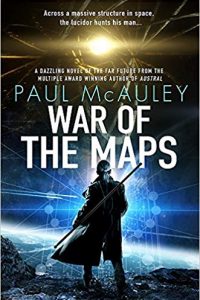Gary K. Wolfe Reviews Noor by Nnedi Okorafor
 Noor, Nnedi Okorafor (DAW 978-0756416096, $23.99, 224pp, hc) November 2021.
Noor, Nnedi Okorafor (DAW 978-0756416096, $23.99, 224pp, hc) November 2021.
As vibrant and inventive as her settings are, Nnedi Okorafor’s most consistent theme may simply be the discovery of unexpected inner powers. Zahrah the Windseeker finds that her dreadlocks give her the power to levitate and fly; Ejii in The Shadow Speaker learns she can hear at great distances and even read minds; Onyesonwu in Who Fears Death? not only discovers an explosive psychic power at her father’s funeral, but becomes a shapeshifter; Sunny the Akata Witch learns she’s a rare ‘‘free agent’’ among the Leopard People; Phoenix in The Book of Phoenix can basically incinerate and resurrect herself; Binti finds she’s a ‘‘harmonizer’’ who can work with aliens; Fatima in Remote Control gains powers literally over life and death, becoming a legendary figure named Sankofa. Those who have read or heard Okorafor’s moving and personal TED talk (published as Broken Places & Outer Spaces) probably have some ideas as to why this theme is so important in her work, as well as why so many of the above characters are outsiders, sometimes even in their own cultures. But biographical criticism can only take us so far, and it’s equally true that the figure of the outsider with special powers, sometimes persecuted because of them, is one of SF’s longstanding traditions – it even has its own entry in the SF Encyclopedia (‘‘Pariah Elite,’’ a term coined by Roz Kaveney). In The Shadow Speaker, Okorafor uses the term ‘‘metahuman’’ for such figures.
Okorafor has also become one of the most prominent American proponents of Africanfuturism, an SFnal expression of lived African experience and culture (as opposed to Afrofuturism, which often focuses on diaspora cultures). Noor, which depending on how you count is only her fourth full-length adult novel (though I’d argue the YA label on some of her best work is often arbitrary), is set almost entirely in northern Nigeria, though it’s a Nigeria which, like much of the world, is largely transformed by an international megacorporation rather unsubtly called Ultimate Corp, whose global tentacles make Amazon look like a neighborhood shop. The narrator, Anwuli Okwudili (who sometimes tells people that her initials AO also stand for Autobionic Organism), is a cyborg, enhanced by powerful prosthetics, both as the result of birth defects and of a ‘‘rare automated-vehicle accident’’ suffered as a teenager. When we eventually learn what may really lie behind AO’s disabilities, it’s absolutely chilling.
AO is also a vulnerable young woman who describes herself as having been ‘‘born outside of beautiful.’’ When she finds herself harassed and then attacked by a group of men, she responds with deadly force, and soon finds herself on the lam in the manner of any number of noir heroes. She meets a Fulani herdsman who also goes by his initials – Dangote Nuhu Adamu, or DNA – and who is also being sought as a terrorist after killing a woman during an attempted massacre of his people and livestock. They become lovers and, given the full Bonnie-and-Clyde treatment by popular media, make their way to the novel’s most striking invention – the Red Eye, a huge, deadly, and permanent cyclonic sandstorm, or aejej, from which they can temporarily protect themselves with an electromagnet shield called an anti-aejej. Hidden within the Red Eye is an entire community protected by such a device on a giant scale, where they find some surprising allies. There they finally begin to unpack some of the novel’s intriguing mysteries, including the role of the gigantic Ultimate Corp wind turbines called Noors that give the novel its title. With its short time frame, characteristically vivid settings, and sharply drawn characters, Noor may be Okorafor’s most tightly plotted novel to date, but it still manages to explore in unsettling ways some of her most passionate themes, including sense of identity, the role of the outsider, cultural intolerance, horrific corporate malfeasance, and government indifference or complicity. It’s such a fast-moving tale that the real punch doesn’t quite hit you until it’s over, but it’s quite a punch.
Gary K. Wolfe is Emeritus Professor of Humanities at Roosevelt University and a reviewer for Locus magazine since 1991. His reviews have been collected in Soundings (BSFA Award 2006; Hugo nominee), Bearings (Hugo nominee 2011), and Sightings (2011), and his Evaporating Genres: Essays on Fantastic Literature (Wesleyan) received the Locus Award in 2012. Earlier books include The Known and the Unknown: The Iconography of Science Fiction (Eaton Award, 1981), Harlan Ellison: The Edge of Forever (with Ellen Weil, 2002), and David Lindsay (1982). For the Library of America, he edited American Science Fiction: Nine Classic Novels of the 1950s in 2012, with a similar set for the 1960s forthcoming. He has received the Pilgrim Award from the Science Fiction Research Association, the Distinguished Scholarship Award from the International Association for the Fantastic in the Arts, and a Special World Fantasy Award for criticism. His 24-lecture series How Great Science Fiction Works appeared from The Great Courses in 2016. He has received six Hugo nominations, two for his reviews collections and four for The Coode Street Podcast, which he has co-hosted with Jonathan Strahan for more than 300 episodes. He lives in Chicago.
This review and more like it in the November 2021 issue of Locus.
 While you are here, please take a moment to support Locus with a one-time or recurring donation. We rely on reader donations to keep the magazine and site going, and would like to keep the site paywall free, but WE NEED YOUR FINANCIAL SUPPORT to continue quality coverage of the science fiction and fantasy field.
While you are here, please take a moment to support Locus with a one-time or recurring donation. We rely on reader donations to keep the magazine and site going, and would like to keep the site paywall free, but WE NEED YOUR FINANCIAL SUPPORT to continue quality coverage of the science fiction and fantasy field.
©Locus Magazine. Copyrighted material may not be republished without permission of LSFF.








